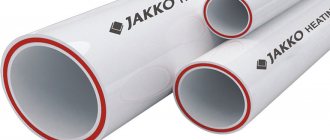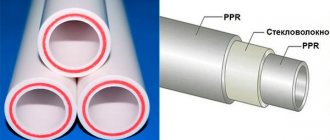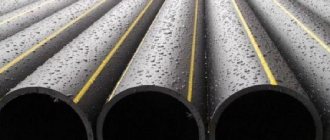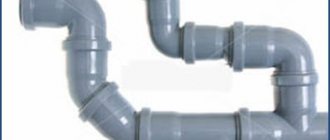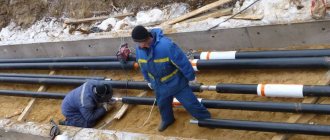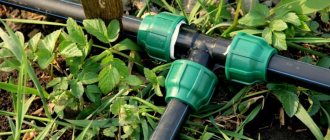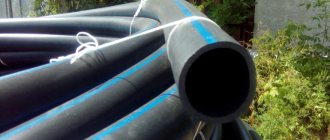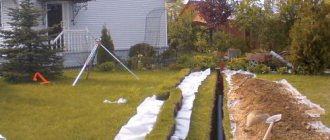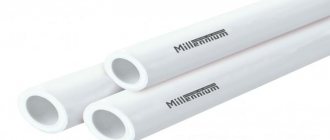What is HDPE pipe
These pipes are made from a polymer called low-density polyethylene. The material is distinguished by such qualities as high strength, lightness, chemical safety (does not enter into any chemical reactions), and the absence of harmful impurities in the material, which is the key to its safety for use. The polymer does not expand when exposed to heat; HDPE pipes have a high coefficient of elasticity (when water in the pipe freezes, the pipe does not burst). Due to the smoothness of the inner walls, plaque does not deposit inside the pipe.
The main advantage of HDPE pipes over others is the ability to install them yourself, without renting special equipment or calling the appropriate specialists. But, despite the wide range of advantages, there are also two significant disadvantages when using HDPE pipes: they cannot be used for installing a hot water supply system. The temperature inside the pipe should not exceed 40°C. And from the direct action of ultraviolet radiation, the polymer quickly loses strength.
Preparation for work
To ensure that the process takes you as little time as possible and is carried out without mistakes that will be difficult to correct in the future, you need to pay attention to some points in advance:
- check that you have a sufficient quantity of both basic materials and related products;
- draw a plan according to which the system will be installed;
- make markings and start cutting.
Only then proceed to the main part of the installation.
Pipe installation
Docking of HDPE fittings
Basically, special fittings are used to connect HDPE pipes. The easiest way to connect these pipes yourself is to install a compression fitting. It can handle water pressure up to 10 atmospheres. The compression type fitting is equipped with the following components:
- fitting body;
- clamping nut;
- collet;
- retaining ring;
- rubber gasket.
Before connecting pipes, their ends should be prepared for installation. Pipe cuts must be strictly perpendicular and free from roughness or burrs. A mark is made along the outer edge of the pipe (in order not to damage the rubber gasket).
Installation of the fitting is carried out as follows: put a clamping nut on the finished pipe in the following order, then a collet and a stopper ring. We place a rubber gasket in the housing. We connect the body to the pipe with pre-assembled parts, and tighten it firmly, with force.
Installation of connections for control and shut-off valves has its own characteristics. One side of the fitting has a special flange, the other has an outlet system for the intended type of connection. The connection of such a fitting is carried out using nuts, bolts and special gaskets.
Subtleties and tips
Although the work does not require much labor, certain difficulties often arise. They are easy to prevent if you pay attention to the following tips:
- If installation requires too much force at the final tightening stage, you can make a small chamfer on your pipe (no more than 1.5 mm). Moisten it with water and you will notice how much easier things will go.
- The cut on the pipe must be perpendicular.
- Pay attention to the rubber seals. There should be no dried grease on them, otherwise installation will be almost impossible - the pipe will not fit. If you find dried grease, try to clean it off using a knife.
- In the absence of special lubricant, ordinary liquid soap will be a good substitute.
- If you plan to bury the pipe system in the ground in the future, it is preferable to use electric welded products. Compression products should be made easily accessible for maintenance, so it is not recommended to embed them in walls or screeds.
- There is no need to use any flax or tow.
If you take into account all the main points, then installing HDPE pipes with compression fittings will not create any special difficulties for you. It is enough to choose reliable materials equipped with appropriate certificates and carefully inspect all components.
It is better to purchase an option that offers the possibility of partial disassembly. Pay due attention to the quality of the selected product, and it is especially important to check the shape of the O-ring. Be sure to note whether the seat has sufficient accuracy, make sure that the technical specifications are in accordance with the upcoming requirements. And at a later stage, carefully carry out all the work, and the procedure will be successful.
Connecting HDPE to polypropylene pipe
Sometimes situations arise when, during the manufacturing process of a pipeline, you have to deal with different pipes made of different materials. Most often, such situations occur during the installation of irrigation systems.
Let's consider the situation using the example of joining a polypropylene (cut) pipe with a HDPE pipe. To connect polypropylene pipes with other types of pipes, specialized fittings have been created with one-sided threads. The part of such a fitting that is without thread is welded to a PP pipe, and the opposite side (where the thread is) is connected to a pipe of the same diameter (made of HDPE).
The thread of the fitting system for joining different types of pipes can be found both externally and internally. It is also possible to install 2 types of these pipes using a part such as a combined coupling. In this situation, a collet connection with thread is attached to the HDPE pipe, and a combined coupling is installed on the propylene pipe. For better sealing, fum tape or a similar sealant is screwed onto the thread before tightening. Next, the structure is screwed in with force.
The simplest way is to connect two types of different pipes (HDPE and polypropylene) using a flange. To improve the sealing properties, a rubber gasket is inserted between the flanges. The structure is tightened with bolts. When preparing pipes from different materials for installation, their dimensional parameters and technological properties should be taken into account; the surfaces to be connected must be cleaned and prepared.
Design Features
The diameter and wall thickness have a direct impact on the scope of application, properties and choice of connection method for low-pressure polyethylene pipes. The SDR index, present in the marking, indicates the relationship between these parameters of these products and their strength characteristics. The table below shows the permissible pressure of the working medium for low-pressure polyethylene pipes with a diameter of 10≤ D ≤1600 mm and a wall thickness of 2≤S≤60 mm. After studying this data, you can choose the optimal connection for HDPE pipes.
Table 1
| Pressure for PE-100, atmosphere | 20 | 16 | 12,5 | 9,5 | 8 | 6 | 4 |
| Pressure for PE-80, atmosphere | 16 | 12,5 | 10 | 7,5 | 6 | 5 | 3,2 |
| Pipe outer diameter, millimeters | SDR9 | SDR11 | SDR13-14 | SDR17 | SDR21 | SDR26 | SDR41 |
| 400 | 44,7 | 36,3 | 29,4 | 23,7 | 19,1 | 15,3 | 9,8 |
| 2315 | 35,2 | 28,6 | 23,2 | 18,7 | 15 | 21,1 | 7,7 |
| 225 | 25,2 | 20,5 | 16,6 | 13,4 | 10,8 | 8,6 | 5,5 |
| 160 | 17,9 | 14,6 | 11,8 | 9,5 | 7,7 | 6,2 | 4 |
| 90 | 10,1 | 8,2 | 6,7 | 5,4 | 4,3 | 3,5 | 2,2 |
| 75 | 8,4 | 6,8 | 5,6 | 4,5 | 3,6 | 2,9 | 2 |
| 63 | 7,1 | 5,8 | 4,7 | 3,8 | 3 | 2,5 | — |
| 50 | 5,6 | 4,6 | 3,7 | 3 | 2,4 | 2 | — |
| 40 | 4,5 | 3,7 | 3 | 2,4 | 2 | — | — |
| 32 | 3,6 | 3 | 2,4 | 2 | — | — | — |
| 20 | 2,3 | 2 | — | — | — | — | — |
Connecting HDPE to a metal pipe
HDPE pipe connections used with metal threads are made mainly to connect HDPE to metal pipes. The need for this type of connection may arise when installing HDPE with metal pipes that are difficult to dismantle (cast iron risers), or when connecting a water supply system to a central main (high pressure), where strong metal composite pipes are used at the outlet, and branches already go from them from polymers.
For the type of connections shown, double-sided fittings are designed, one side of which is threaded, and the other has a compression value. This type of fittings is connected using the principle of a “collet connection with a coupling”. A dismountable section of the fitting is mounted on a pipe made from HDPE, secured by welding, and later the threaded element is attached to the metal pipe. If it is impossible to use the welded connection principle, a flange system is used. An unlimited selection of pipe fitting models can be adapted to suit any need.
Advice from experienced specialists
The ellipticity of the material can negatively affect the tightness. In this case, the seams will be of poor quality. If the contact is made by welding, then it is important to monitor the immobility of the pipes until the materials completely harden.
Equipment for welding seam Source i.ytimg.com
The ends of the products to be joined must be prepared in advance. This means removing dirt and dust. Additionally, you need to treat the surface with a degreaser.
If fittings with clamping nuts are used, it is important to tighten them to the limit, but not significantly. Excessive force may cause the element to burst. And the collet in this case is capable of crushing the end part of the pipe.
Connecting HDPE pipe to hose
To connect the HDPE pipe and the watering hose, you do not need special soldering equipment. You just need to purchase a special compression-type fitting; for pipes made from HDPE, it is better to come complete with a shut-off and control valve. The principle of joining a HDPE pipe and a watering hose is similar to the process of combining pipe fragments. Fitting systems for connecting a hose at the outlet are equipped with a specialized “herringbone outlet”, onto which a hose of the required length is subsequently stretched and crimped with a clamp of the required size. Installing a fitting with a tap is more convenient; it is more practical to dismantle it if necessary, with the onset of the autumn-winter season. To turn off the water supply, there is no need to shut off the entire water supply system; just close the outlet tap. For faster installation, there is a ready-made option - a HDPE tap, where the water pressure control and the fitting for fixing to the pipe are one whole.
Using Welding Equipment
The connection of water supply elements is possible by welding. For this, a soldering iron with special cups is used. The device is powered from the electrical network and does not require expensive maintenance or complex setup.
Sequence of work.
- Cleaning the connecting sections of the pipeline.
- Selecting a suitable fitting.
- Heating the pipe and fitting using a soldering iron.
- Connection of two elements.
The resulting connections are non-separable and have excellent tightness.
An important nuance: the soldering iron cups must match the diameters of the pipes being connected.
Joining HDPE pipes with PVC
When connecting HDPE pipes with pipes made of polyvinyl chloride, certain parameters must be taken into account. Pipes made of low-pressure polymer can transport any fluid. Products made from polyvinyl chloride are used only for moving liquids. Compared to HDPE pipes, PVC pipe can withstand up to sixty degrees Celsius. But the frost resistance of these types of pipes is different. When the ambient temperature drops to minus 10°C, the polyvinyl chloride pipe may begin to crack. At high loads (water pressure in the pipe), HDPE is stronger than polyvinyl chloride. Therefore, due to the significant difference in technical characteristics, direct welding of these types of pipes is categorically not recommended. If this parameter is violated, sometimes allowed by incompetent specialists, sudden destruction of the pipe section may occur. Separate sections of polyvinyl chloride pipes are mounted between each other by electrofusion welding or contact soldering.
Pipes made from low-pressure polyethylene (polymer) are harmless to human health because they are chemically inert, and a polyvinyl chloride pipe, deteriorating over time, can begin to release toxic substances (chlorides) into the transported environment. Therefore, pipes made of polyvinyl chloride are used more often only for free-flow transportation of sewage, technical water supply systems, irrigation and drainage.
It is not recommended to use polyvinyl chloride in a water supply system intended for direct human use (water for cooking). Although, for domestic water supply systems there is a special version of polyvinyl chloride, its unplasticized form, which does not release toxic substances into the moving environment. When installing pipes of different structure materials (HDPE and PVC), it is recommended to use special transition modules. This is the only way to avoid problems with liquid leakage, ensure the tightness of the connection, and prevent possible damage to the pipe section.
Required characteristics
It is impossible to say for sure which products are best to use when you intend to assemble it yourself. First of all, the following factors should be considered:
- Size. The most common products are 15-110 mm. Such characteristics are due to the fact that you are unlikely to find pipes with smaller indicators when it comes to diameter.
This is dictated by the properties of the material itself, so that HDPE pipes have the required strength and stability, the walls must be thick enough. Naturally, the diameter should leave room for cross-country ability, which led to the mentioned trend.
Fittings with a diameter of more than 110 mm are also used, but are used extremely rarely in private construction.
- Pressure and temperature. Although such products can withstand high temperatures, it is necessary to take into account the fact that when using pipes Ø no higher than 63 mm with a temperature of 20°, the technology requires not to rely on a pressure that would exceed 16 bar, and with higher values you should not cross the border of 10 bar.
Assembling pipes with fittings
- Thread quality. Here it is worth inspecting the product and reading the certificate, which will indicate the standards that were met during production.
- Possibility of use for drinking water. It is confirmed by the corresponding conclusion. The latter is issued based on the results of a hygienic examination, so be sure to check its availability if you intend to use your fittings in this type of water supply.
Be sure to pay attention that the selected products are suitable in all respects for the type of pipes used and correspond to the upcoming loads. Please note that the indicated pressure parameters are focused specifically on the working load, i.e., the one that the fittings will have to withstand during their service life. A slight increase will not immediately destroy your water supply, but the service life will be noticeably reduced.
Butt welding
This method is used to assemble systems from pipes with a diameter of 50 mm or more.
To do this, you need a soldering iron for welding HDPE. Such equipment is inexpensive and is sold in almost any hardware store, so there should be no problems with the purchase. The process goes like this:
The ends of the pipes are fixed in the apparatus, after which a heated plate is brought to them. When the polyethylene begins to melt, the plate is removed and the pipes are connected to each other under slight pressure. After the seam has cooled, the clamps are removed and the pipes are removed.
Technological features of the method:
- Used to connect elements of the same diameter. You cannot weld parts with a wall thickness of less than 5 mm. Welding can only be done at temperatures from +15° to +45° C.
Electrofusion welding
The pipeline assembled using electric couplings is capable of withstanding pressure up to 16 atmospheres. But, for each joint it is necessary to purchase special overlays - electric welded couplings. These parts are quite expensive, so if you plan to make a lot of connections, it is better to use butt welding.
Conditions that must be met before starting work:
- Cleaning the ends; Rigid fixation of the elements to be welded.
The process itself looks something like this:
- The ends of the pipes are cut to form a right angle and chamfered; The ends are cleaned; The pipes are fixed in the coupling and power is supplied to the terminals; The device is turned on, with the help of heating the surface inside the coupling is softened; The device and wires are disconnected; The resulting joint is cooled.
Plug-in connection
In this way, the pipes are fixed in the event that dismantling may be necessary in the future or the use of welding is impossible or impractical. Of course, such fastening is not as reliable as welding, but it still has its advantages:
- Savings - no need to purchase additional equipment. Quick installation - the pipeline is assembled in almost a couple of hours. Detachable connections are made where welding is not possible, for example, under water.
On a note!
The socket connection is mainly used for the installation of gravity pipelines, for example, for sewerage. Connection using fittings is similar in reliability to welding, so it can also be used for installing water pipes.
So, for a system in which liquid is transported by gravity, one of the two simplest methods is used:
- Into the socket - one end of the pipe is inserted into the socket of the previous one, and rubber or silicone seals are used for tightness. Fitting or flanged - the pipeline is connected using special parts.
Scope of application
HDPE is used exclusively for cold water pipelines, as it can be operated at a temperature of no more than 40 °C. Working pressure – no more than 20 MPa (2 atmospheres). They are used everywhere for laying water supply and sewerage networks underground and water supply systems from a well with a pump.
Wider distribution is hampered by instability to ultraviolet radiation - it will not be possible to completely switch to HDPE.
In addition, communication or power supply cables are laid in smooth or corrugated tubes.
Advantages and disadvantages of these pipes:
Connection with couplings
The couplings are made of polyethylene and are widely used in pipeline assembly. In addition to the fact that with their help you can quickly and without unnecessary hassle assemble pipes into a single whole, they also have a number of advantages:
- The result is a reliable fastening with a long service life; Withstands temperature changes and mechanical stress; Can be used for any type of pipeline. Affordable price.
The pipeline is installed using different types of couplings:
- Compression - can have different threads: external or internal. Compression couplings can be used even when assembling gas systems and water supply systems. Connecting couplings - connect elements of the same diameter. Reducing couplings - are indispensable for connecting elements of pipes of different diameters.
